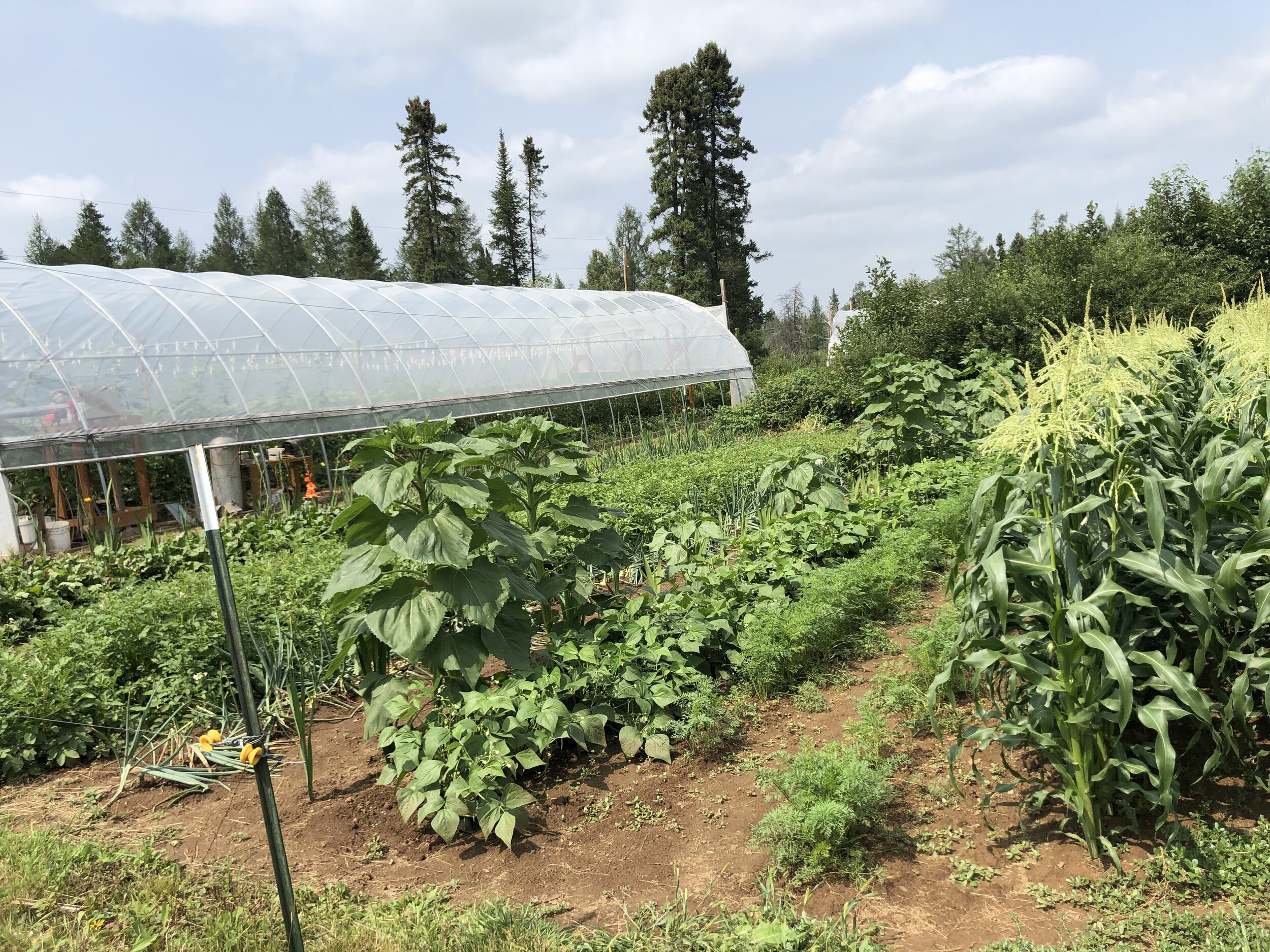Geary Shaw on his farm
The music blares all night in Geary Shaw’s high tunnels….to keep the bears away. And the sprinkler propped on top of a ladder delivers well water all day……to keep the outside crops like squash and corn going in this drought. They’re protected from bears and abundant deer by an electric fence. Crops like tomatoes, peppers, broccoli, cabbage and cauliflower fill the two large high tunnels and are drip irrigated. Geary and Deb bought these 60 acres near Embarrass in 1997. We’re standing on the 20 acres with gardens and hoop houses. The other 40 are across the road and kept in a forest management program.
Farming is in Geary’s blood. He grew up on a farm in Indiana, drove a tractor by age 5 and farmed his grandpa’s land at age 13. Geary provided the labor, and the old man gave him 1/3 of the profits. He took a break to go to diesel mechanics school and worked in that field for 5 years. But farming was in his blood. So he went back, working on a 2,500 acre farm that grew corn for ethanol and soybeans, as many other farms did. But most of this farm was focused on peppermint and spearmint, perennials that are grown like hay and mowed. After mowing, they are raked up and blown into rolling tanks and taken to the still where they are steamed until the oil floats. The oil goes into 55-gallon barrels (about 550 pounds of oil). It’s typical to get about 60 pounds per acre, so 9 acres would fill a barrel. Wrigley’s and Colgate bought the oil, and you know the rest of that story.
The farm also grew 80 acres of onions, yielding about 1,000 bushels per acre. They sorted and bagged them and sold them to Kroger’s distribution center in Louisville. Diversified farms like that were not so common in Indiana and Illinois where I grew up. Most of my farming relatives had corn and soybeans and hogs or cattle. But smaller, diversified farms growing “specialty crops” as the non-commodity crops are known, are the norm in northern Minnesota. And that’s what Geary has now. Homegrown in Embarrass, the company that he and his wife Debra run, provides fresh produce to several area retailers and to many neighbors and friends who stop by to get their veggie fix.
Tomatoes are close to ready in early August
It fed their family of four with fresh and preserved produce for many years. And it contributed to the Babbitt Farmers Market (which is no longer running). Geary established a relationship with Natural Harvest Food Coop and still supplies them with local produce. And his farm is one of five participating in the experimental aggregated CSA begun by the Rutabaga Project this year. The CSA collects produce from multiple farms and “aggregates” it into share boxes which are then delivered to customers. If the experiment is successful, the program will expand to sell CSA shares next year.
Early in the spring, about March 15 when the snow is likely still on the ground, Geary starts everything from seed under grow lights in the family room. He moves the crops outside as early as he can. The high tunnel nearest the house is heated, so he can get a good head start on tomatoes and peppers. He plants things like broccoli, cabbage and cauliflower later in the year to avoid bugs and harvests them in October. He prefers to outsmart the bugs so that he doesn’t have to use insecticide sprays. Good quality soil prevents pests, too, and Geary tests his soil every year and adjusts. His friend a few farms away provides plentiful manure. Geary hauls it home in the fall and lets it sit over the winter before mixing it in with the soil in spring.
The south high tunnel and adjacent crops
He relies on Seeds ‘N Such in Graniteville, South Carolina for non-GMO seeds. Like Geary, farmers up here usually have a favorite seed provider. Some use Johnny’s in Maine, some Jung’s in Wisconsin, many use High Mowing Seeds in Vermont, and some buy locally from Seed Treasures in Angora, Minnesota or North Circle Seeds in Vergas, Minnesota. More and more folks are saving their own seeds, too. Many of us ran into seed shortages in 2020 and again in 2021 as folks, spurred by Covid’s disruption of the food supply chain, began planting their own gardens. And then the 100-year drought of 2021 slowed us all down a bit.
Geary uses grow lights inside early in the spring and high tunnels or hoop houses for season extension outside. They allow him to plant early and late and to avoid the frost damage that so often threatens Embarrass, Minnesota. For example, as I write this on August 13, Geary reports 35 degrees last night. Embarrass is located in a low basin of the Embarrass River Valley and parts of Geary’s land are wet in a normal season. Heading out his back door into the wooded area, he tells me you would usually get your feet wet…. not this year! But he plants on the high spots and, even this year, has stellar-looking crops. Let’s cross our fingers for rain late in the season!
A row or two of gladiolas brightens up the field



